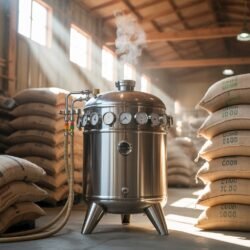Anaerobic fermentation is increasingly recognized not only for its unique flavor profiles but also for its potential to offer more sustainable coffee processing options compared to traditional methods. However, like all agricultural techniques, it comes with its own set of environmental impacts and considerations.
Water Usage and Conservation
Anaerobic fermentation stands out for its relatively low water requirements. Unlike washed processing, which can use up to 130 liters of water per kilogram of coffee cherries, anaerobic processing takes place in sealed tanks and minimizes the need for additional water. This makes it a particularly attractive option in regions facing water scarcity or where freshwater resources are under pressure from climate change. The reduction in water usage directly translates to lower environmental stress on local ecosystems and communities.
Energy Consumption
While anaerobic fermentation reduces water use, it does require energy to regulate temperature and monitor fermentation conditions inside the tanks. Depending on the energy source—renewable or non-renewable—this can influence the carbon footprint of the process. If renewable energy is used, the environmental impact remains relatively low, but reliance on fossil fuels can offset some of the sustainability benefits.
Waste Generation and Management
Anaerobic fermentation generates less organic waste compared to washed processing, but it still produces effluent from the tanks that can be rich in organic matter. If not properly managed, this effluent can contribute to water pollution, similar to the challenges posed by untreated wastewater from washed processing. However, the total volume of waste produced is significantly smaller, and with proper treatment or reuse (such as composting or use as fertilizer), the environmental risk can be minimized.
Comparison with Other Processing Methods
– Natural (Dry) Processing: Uses minimal water and energy, but can produce large quantities of organic waste if not managed properly.
– Washed (Wet) Processing: Highly water- and energy-intensive, with significant waste and wastewater challenges.
– Anaerobic Fermentation: Uses less water, moderate to high energy (depending on temperature control), and generates less waste than washed processing.
Sustainability Practices in Anaerobic Fermentation
To maximize the sustainability of anaerobic fermentation, producers should:
– Use renewable energy sources for temperature control and monitoring.
– Implement effective waste management systems to treat or reuse fermentation effluent.
– Adopt closed-loop systems where possible, recycling water and organic byproducts.
– Monitor and minimize energy use by optimizing fermentation times and conditions.
Conclusion
Anaerobic fermentation offers a more sustainable alternative to traditional washed processing, primarily through reduced water usage and lower waste generation. However, its environmental benefits depend on responsible management of energy use and waste. By adopting best practices and leveraging renewable resources, producers can further enhance the sustainability of anaerobic coffee processing and contribute to a more environmentally friendly coffee industry.


